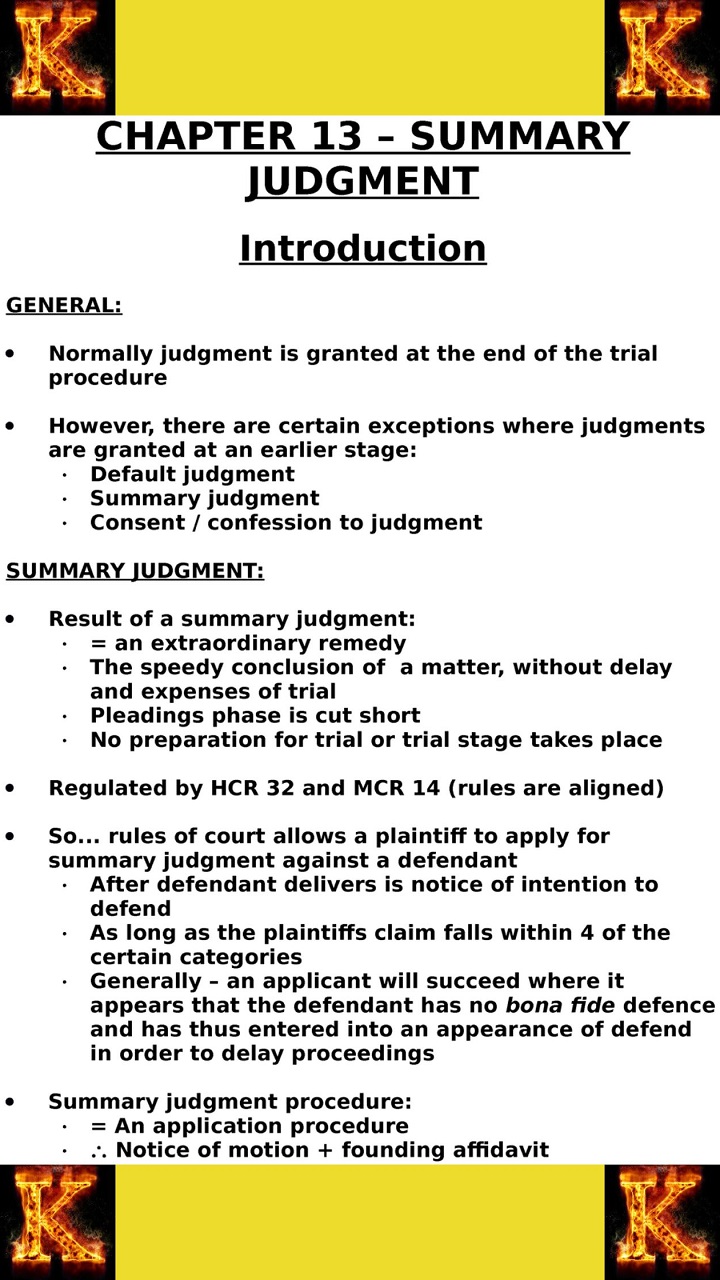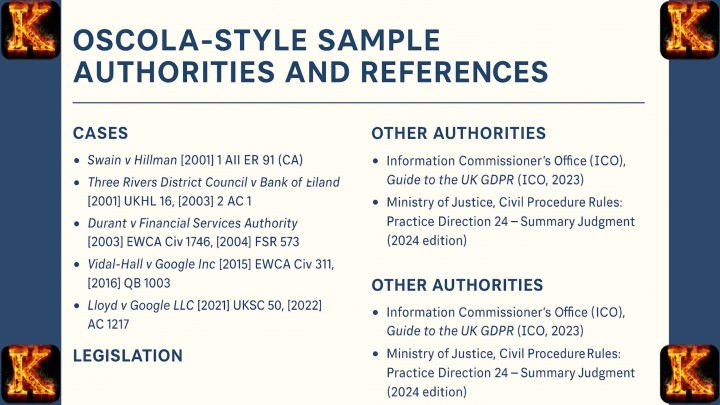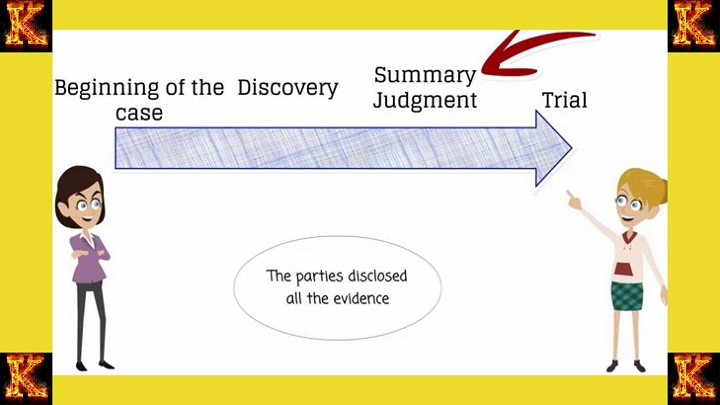A skeleton argument for summary judgment is a concise, structured document submitted to the court in support of an application for summary judgment under the relevant procedural rules (for example, Part 24 of the UK Civil Procedure Rules). Its purpose is to outline the essential legal arguments, supporting authorities, and material facts demonstrating that the applicant is entitled to judgment without the need for a full trial.
The argument should identify the specific issues in dispute, explain why the respondent has no real prospect of succeeding on those issues, and address why there is no other compelling reason for the case to proceed to trial. It will typically refer to pleadings, witness statements, and documentary evidence already before the court, while keeping the content focused and avoiding unnecessary detail.
A well-prepared skeleton argument enables the court to quickly grasp the basis of the application, assess the strength of the evidence, and determine that the opposition’s case lacks substantive merit, thereby saving time and costs for all parties.

The Purpose of a Summary Judgment Skeleton Argument
Achieving summary judgment and avoiding trial
The primary objective of a skeleton argument for summary judgment is to persuade the court that there is no real prospect of the opposing party succeeding at trial and that there is no compelling reason for the matter to proceed. This may apply to the entirety of the claim or to specific issues within it. Where successful, summary judgment eliminates the need for a full hearing, saving significant time, legal costs, and court resources.
Presenting key arguments
A well-prepared skeleton argument distils the essential facts, evidence, and legal principles into a clear and concise structure. It should highlight why the applicant, often the claimant, is entitled to judgment without further litigation. This requires a systematic review of pleadings, witness statements, expert reports, and documentary evidence to expose any weaknesses, contradictions, or gaps in the opponent’s case. The argument should directly address the issues raised by the opposition, demonstrating why they are immaterial, speculative, or incapable of proof at trial.
Citing relevant law and precedent
The skeleton argument must be firmly grounded in the applicable procedural framework, such as Civil Procedure Rule (CPR) 24.2 in the UK, which sets the legal test for granting summary judgment. The applicant should link the facts of the case to the requirements of the rule, showing that:
-
The respondent has no real prospect of succeeding on the claim or issue; and
-
There is no other compelling reason for a trial.
Supporting authorities, ideally from higher courts, should be cited to illustrate how similar cases have been decided in favour of summary judgment. References to persuasive authorities from other jurisdictions may also be considered if relevant. By aligning the application with established legal precedent, the skeleton argument reinforces its credibility and persuasiveness.
Strategic function
Beyond meeting the procedural test, the skeleton argument also serves a strategic purpose: it shapes the judge’s first impression of the case. Because summary judgment hearings are often brief, the clarity, organisation, and persuasive quality of the skeleton argument can heavily influence the court’s decision.
Read Also: Skeleton Argument for a Case Summary Judgment
What Are You Trying to Achieve When Writing a Summary Judgment Skeleton Argument?
Early resolution
The primary aim is to secure a judgment in favour of the client without proceeding to a full trial. This is based on the premise that the other party has no real prospect of defending the claim or advancing a viable counterclaim. Achieving an early resolution allows the dispute to be concluded swiftly, freeing the client from the uncertainty and stress of prolonged litigation.
Avoiding unnecessary cost and delay
Summary judgments are cost-efficient because they avoid the expense, time, and procedural complexity of a full trial. They are particularly appropriate where the facts and law are clear, and a trial would only result in needless expenditure of court and client resources. This also aligns with the court’s duty to manage cases justly and proportionately under procedural rules such as CPR 1.1 in the UK.
Strengthening the applicant’s case
The skeleton argument acts as a persuasive legal brief, bringing together the strongest factual evidence and legal reasoning to show why judgment should be granted without trial. A well-structured argument narrows the issues in dispute, demonstrates the inevitability of the outcome, and leaves the opponent with little room to argue that a trial is necessary.
Exposing weaknesses in the opponent’s case
A key objective is to undermine the opposing party’s position. This may involve highlighting their lack of credible evidence, reliance on irrelevant or inadmissible material, misinterpretation of the law, contradictions in their statements, or inconsistencies in their pleadings. By systematically dismantling the opponent’s arguments, the applicant reinforces the case for summary judgment.
Ensuring compliance with procedural requirements
The skeleton argument should clearly address the legal test under the relevant procedural rule (e.g., CPR 24.2) and demonstrate compliance with all procedural requirements for making a summary judgment application. This procedural discipline increases the likelihood that the court will entertain and grant the application.
Framing the case for the judge
Since summary judgment hearings are often brief, the skeleton argument plays a crucial role in shaping the judge’s first impression. It must be clear, concise, and logically organised so that the judge can quickly grasp why the case should be decided without trial.
Contributing to efficient case management
By removing meritless claims or defences from the court’s docket, summary judgment promotes the efficient use of judicial resources. This supports the wider goal of reducing court backlogs and ensuring timely justice for all parties.

Skeleton Argument Guide for Summary Judgment Application Structure
A skeleton argument for a summary judgment application should be structured in a clear, logical, and persuasive manner. Below is a detailed guide to the sections and the type of content to include.
TITLE PAGE
-
Court Information – Include the name of the court, the claim number, and the division (if applicable) at the top of the page.
-
Case Title – State the names of the claimant(s) and defendant(s) in the format: [Claimant] v [Defendant].
-
Document Title – Clearly label the document as:
“CLAIMANT’S APPLICATION FOR SUMMARY JUDGMENT: SKELETON ARGUMENT” -
Date – Provide the date of submission.
-
Applicant’s Details – Optionally, include the name of the legal representative, law firm, or litigant in person.
INTRODUCTION
-
Summary of Application – Begin with a short statement describing the nature of the application.
-
Reference to Procedural Rules – Identify the governing rule (e.g., CPR 24.2 or CPR 24.3 in the UK).
-
Purpose of Application – State that the claimant is seeking judgment without trial because the defendant has no real prospect of success and there is no compelling reason for a trial.
-
Example:
“This is an application on behalf of the claimant for summary judgment in accordance with CPR 24.3. The claimant submits that the defendant has no real prospect of successfully defending the claim and there is no compelling reason why the matter should proceed to trial.”
EVIDENCE
-
List of Relevant Documents – Identify all documents and exhibits the court should consider (e.g., pleadings, contracts, witness statements, invoices, correspondence).
-
Brief Description – For each document, provide a short explanation of its purpose and relevance, along with its date.
-
Example:
“Witness Statement of [Name], dated [Date], which sets out the events leading to the dispute and rebuts the defendant’s allegations.” -
Organisation of Evidence – Refer to exhibit numbers consistently and ensure they are properly paginated in the bundle.
CASE LAW
-
List Supporting Authorities – Include cases that establish principles relevant to summary judgment and to the substantive issues in dispute.
-
Brief Summary – For each case, summarise the legal point it supports.
-
Example:
-
Swain v Hillman [2001] 1 All ER 91 – Clarifies that “no real prospect” means more than a fanciful chance of success.
-
Three Rivers DC v Bank of England (No 3) [2001] UKHL 16 – Explains how the court should assess whether there is a real prospect of success.
-
LEGISLATION
-
Relevant Statutes – List statutes and regulations that apply to the dispute.
-
Explain Relevance – Briefly state how each provision supports the claimant’s position.
-
Example:
“The claimant relies on section 13 of the Supply of Goods and Services Act 1982, which implies a term that the supplier will carry out the service with reasonable care and skill.”
FACTUAL BACKGROUND
-
Concise Timeline – Present a chronological summary of key events, including dates, correspondence, and contractual milestones.
-
Focus on Material Facts – Include only facts directly relevant to the application; avoid unnecessary narrative.
-
Example:
“On 12 January 2024, the claimant delivered the goods in accordance with the contract. On 18 January 2024, the defendant refused payment without identifying any breach.”
COURT’S DISCRETION
-
Application of CPR 24.3 – Set out the court’s powers to grant summary judgment.
-
Why No Trial is Needed – Demonstrate that the dispute can be resolved entirely on the available evidence without oral testimony.
LIMB 1: NO REAL PROSPECT OF SUCCESS
-
Reference Authorities – For example, Swain v Hillman as the leading authority.
-
Legal Reasoning – Explain why the defence is bound to fail.
-
Factual Points – Highlight inconsistencies, lack of evidence, or admissions made by the defendant.
-
Examples of Weaknesses:
-
Defence based on misinterpretation of contractual clauses.
-
Lack of corroborating documentation.
-
Reliance on allegations contrary to contemporaneous records.
-
LIMB 2: NO COMPELLING REASON FOR TRIAL
-
Explain why Oral Evidence is Unnecessary – Show that the issues are purely legal or can be decided on documents.
-
Procedural Efficiency – Argue that proceeding to trial would waste judicial resources and cause unnecessary cost.
CONCLUSION
-
Restate the order sought – e.g., that the court grants summary judgment in favour of the claimant in the amount claimed, with interest and costs.
-
Include a draft order for the judge’s consideration.

Also Read: Hire a Nerd to Write Your Law Papers
Sample Skeleton Argument for a Summary Judgment Application
IN THE HIGH COURT OF JUSTICE
QUEEN’S BENCH DIVISION
Claim No: QB-2024-001234
BETWEEN
Jane Smith (Claimant)
and
DataSecure Ltd (Defendant)
CLAIMANT’S APPLICATION FOR SUMMARY JUDGMENT: SKELETON ARGUMENT
Date: 9 August 2025
INTRODUCTION
-
This is the Claimant’s application for summary judgment pursuant to CPR 24.2 and CPR 24.3.
-
The Claimant submits that the Defendant has no real prospect of successfully defending this claim for damages arising from a breach of statutory duty under the UK General Data Protection Regulation (“UK GDPR”) and the Data Protection Act 2018 (“DPA 2018”).
-
There is no compelling reason for the matter to proceed to a full trial. The facts are clear, undisputed in material respects, and supported by documentary evidence.
EVIDENCE
The Claimant relies upon the following evidence:
-
Witness Statement of Jane Smith dated 15 July 2025, detailing the circumstances of the data breach and its impact on her.
-
Letter from the Information Commissioner’s Office (ICO) dated 10 April 2025, confirming that the Defendant was in breach of Article 5(1)(f) UK GDPR by failing to implement appropriate security measures.
-
Internal Email Chain from the Defendant dated 3 March 2025, acknowledging that the personal data of 2,000 customers, including the Claimant, was exposed to unauthorised third parties.
-
Medical Report of Dr. Alan Green dated 20 June 2025, confirming that the Claimant suffered anxiety and sleep disturbance as a result of the breach.
CASE LAW
The Claimant will refer to:
-
Vidal-Hall v Google Inc [2015] EWCA Civ 311 – confirming that damages may be awarded for non-material loss (e.g., distress) under the DPA.
-
Lloyd v Google LLC [2021] UKSC 50 – clarifying the requirements for proving damage in data protection claims.
-
Swain v Hillman [2001] 1 All ER 91 – establishing that “no real prospect of success” means more than a fanciful chance.
LEGISLATION
The Claimant relies on:
-
Article 5(1)(f) UK GDPR – requiring controllers to ensure appropriate security of personal data.
-
Article 32 UK GDPR – setting out specific security obligations.
-
Section 168 DPA 2018 – enabling compensation for material and non-material damage caused by a breach.
FACTUAL BACKGROUND
-
The Claimant was a registered customer of the Defendant, providing her personal data, including name, address, and bank account details, in the ordinary course of business.
-
On 2 March 2025, the Defendant’s unsecured server was accessed by unknown third parties, resulting in the unauthorised disclosure of the Claimant’s personal data.
-
The Defendant has admitted the breach in correspondence with the ICO and in its Defence, but contends that the breach caused no actionable damage to the Claimant.
-
The Claimant suffered emotional distress and took time off work as a direct result of the breach.
COURT’S DISCRETION UNDER CPR 24.3
The court may grant summary judgment where:
-
The Defendant has no real prospect of successfully defending the claim; and
-
There is no other compelling reason for the matter to proceed to trial.
LIMB 1: NO REAL PROSPECT OF SUCCESS
-
The Defendant has admitted the occurrence of the breach.
-
Liability under the UK GDPR and DPA 2018 is strict in nature once a breach is established; the Defendant’s argument that “no actual harm” occurred is legally unsustainable in light of Vidal-Hall.
-
The Defendant has produced no evidence to contradict the medical evidence of distress suffered by the Claimant.
LIMB 2: NO COMPELLING REASON FOR TRIAL
-
The facts are largely uncontested and the legal principles are settled.
-
The matter can be determined entirely on documentary evidence without the need for oral testimony.
-
Proceeding to trial would incur unnecessary costs and delay contrary to the overriding objective in CPR 1.1.
CONCLUSION
The Claimant respectfully requests that the Court:
-
Grants summary judgment in her favour.
-
Awards damages in the sum of £8,000 for distress and associated losses.
-
Orders the Defendant to pay the Claimant’s costs of the application and the claim.
Draft Order attached.

OSCOLA-style Sample Authorities and References
Cases
-
Swain v Hillman [2001] 1 All ER 91 (CA)
-
Three Rivers District Council v Bank of England [2001] UKHL 16, [2003] 2 AC 1
-
Durant v Financial Services Authority [2003] EWCA Civ 1746, [2004] FSR 573
-
Vidal-Hall v Google Inc [2015] EWCA Civ 311, [2016] QB 1003
-
Lloyd v Google LLC [2021] UKSC 50, [2022] AC 1217
Legislation
-
UK General Data Protection Regulation (UK GDPR) (Regulation (EU) 2016/679, as retained in UK law)
-
Civil Procedure Rules 1998, Part 24 (Summary Judgment)
-
Civil Procedure Rules 1998, Part 1 (Overriding Objective)
Other Authorities
-
Information Commissioner’s Office (ICO), Guide to the UK GDPR (ICO, 2023)
-
Ministry of Justice, Civil Procedure Rules: Practice Direction 24 – Summary Judgment (2024 edition)

Conclusion
In closing, the claimant reiterates that the evidence, legal authorities, and applicable procedural rules clearly demonstrate that the defendant has no real prospect of successfully defending the claim and that there is no compelling reason for the matter to proceed to a full trial, in accordance with CPR 24.2.
The claimant has:
-
Set out the relevant facts in a concise yet comprehensive manner.
-
Established the legal basis for the claim through binding case law and statutory provisions.
-
Highlighted the absence of any credible or admissible evidence from the defendant that could undermine the claim.
-
Demonstrated the procedural efficiency and proportionality in granting summary judgment to avoid unnecessary costs, delay, and the consumption of judicial resources.
In light of the above, the claimant respectfully requests that the Court:
-
Grant summary judgment in favour of the claimant on the claim.
-
Dismiss the defendant’s defence and/or counterclaim in its entirety.
-
Award costs of this application to the claimant, to be assessed if not agreed.
-
Make any further orders the Court deems just and appropriate for the enforcement of the judgment.
The claimant further submits that granting this application would be consistent with the overriding objective under CPR 1.1, ensuring that cases are dealt with justly, expeditiously, and proportionately, without unnecessary expenditure of time or public resources.
